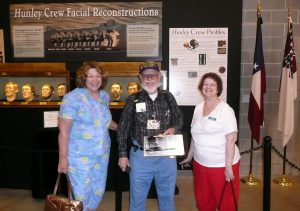|

Thanks to the efforts of several people, most notably crewmember Roger
Gibson and Josephine Starnes of the Hunley museum, we were able to set up a
private tour of the Hunley and the Hunley museum. What a spectacular
opportunity to see such a great piece of history.

Our most wonderful tour guide, G. D. Hinkle Sr. with
Suzanne Grissom (L) and Penny Marquis (R)
The following article was taken from the March 2004 issue of Southern Living Magazine
The Hunley Whispers Its Secrets
Why did this submarine sink? Who were the men aboard? Dr. Robert Neyland and his team of scientists search for answers.
Just the sight of this ghost vessel raises goose bumps. Finally, after lying lost under Charleston Harbor for 136 years, there it is. The H. L. Hunley, the first submarine to sink a ship in battle and the iron coffin of its eight-man crew, chills in a cradle of cold seawater at Warren Lasch Conservation Center in North Charleston, South Carolina.
For more than three years after the sub’s recovery, a team of experts has hovered around the Hunley on a mission of mercy and science. As they excavated the interior, filled with 1 1/2 tons of silted black sediment, they respectfully recovered those entombed inside since 1864. Thousands are expected in Charleston for ceremonies on April 17, when the submariners are laid to rest in Magnolia Cemetery.
A future museum will house the Hunley and its artifacts. Until then, the new “crew” will finish the sub’s journey from lost legend to museum artifact. “Every day is a new day. Every day is a day of unknowns,” says Dr. Bob Neyland, director of the Hunley project, who expects conservation and analysis to take 7 to 10 more years.
A native of Palestine, Texas, Bob graduated from the Nautical Archaeology Program at Texas A&M University and is now chief of underwater archaeology for the Navy Department’s Naval Historical Center. (The federal government owns the vessel. The South Carolina Hunley Commission, a state agency, oversees the project.) Experts ranging from a geologist to a genealogist report to Bob, including senior conservator Paul Mardikian and senior archaeologist Maria Jacobsen. Associates call Maria “Goldfinger” because she always seems to find prized artifacts.
Several scientists, including Dr. Jamie Downs, forensic pathologist with the Georgia Bureau of Investigation in Savannah, donate their time and expertise. “The first time I put my hands on the Hunley, I got weak in the knees,” recalls the Charleston native, who grew up fascinated with stories about the sub. “The only other times I felt like that were when I got married and when our children were born.”
Each day the team work around the curls of question marks. On the night of February 17, 1864, the Hunley rammed an explosive, mounted on a 16-foot spar, against the U.S.S. Housatonic and sank the vessel, then went down itself. When and why did the submarine sink? Who were the men aboard, and how did they die?
The super-secret Hunley left in its wake a paper trail so thin even the vessel shape was a mystery. Late 19th-century drawings depicted a fat iron cigar. Instead, it arose from its grave sharp and sleek with its spar intact–a relic as quaint yet curiously contemporary as a Jules Verne daydream. Racing ahead of their time, its creators dove under the prevailing winds of wood-and-sail naval design and sculpted from iron a 39-foot stealth weapon.
“It’s not crude at all,” Bob says of the sub’s graceful lines. “It’s very sophisticated, with good hydrodynamic designs. We thought there would be water dripping out of it, but it is incredibly tight.”
It’s also incredibly small, especially for crewmembers who stood as tall as 6 feet. To enter it, they squeezed through a hatch the size of a stew pan, then bent themselves double into an interior that measures 3 feet, 10 inches wide and 4 feet, 3 inches high.
Who were Lt. George Dixon, the Hunley commander, and the crewmen at the sub’s hand crank: Arnold Becker, C.F. Carlson, C. Simkins, James Wicks, Frank Collins, Joseph Ridgaway, and a man known only as Miller? From skeletal remains, Dr. Doug Owsley, division head of physical anthropology for the Smithsonian, finds evidence of both European and American diets, heavy tobacco use, infections, injuries, and tooth decay.
Few biographical clues emerge from the artifacts, which include canteens, pipes, pocketknives, and empty wallet, shoes, a slouch hat, a silk bandanna, stubs of two pencils, a housewife (a Civil War soldier’s sewing kit), and the golden sparkle of a love story. A Mobile girl gave a $20 gold piece to Lieutenant Dixon who carried it into the Battle of Shiloh, where it deflected a bullet and saved his life. He later had “My Life Preserver” inscribed on one side of the bent coin and kept it as a talisman. One day “Goldfinger” felt the edge of a coin, brushed away the muck, and read the inscription.
Meanwhile, Jamie studies another “text.” He hopes to determine stress levels from marker chemicals found in brain tissues. Those may reveal how the crew perished; in sudden terror or by gradual descent into sleep from oxygen loss. Either way, the teardrop flame from a small candle found in the sub may have been the last light they saw.
More than just naval history urges Jamie to put his hands on the Hunley again and again. “It’s the humanity of their story,” he says. “You may not agree with their cause, but they gave birth to the modern navy. They got into this coffin and made history, and they did it as volunteers.” Gary D. Ford
The Hunley project: 1250 Supply Street, North Charleston, SC 29405; (843)
722-2333 or
www.hunley.org.
|